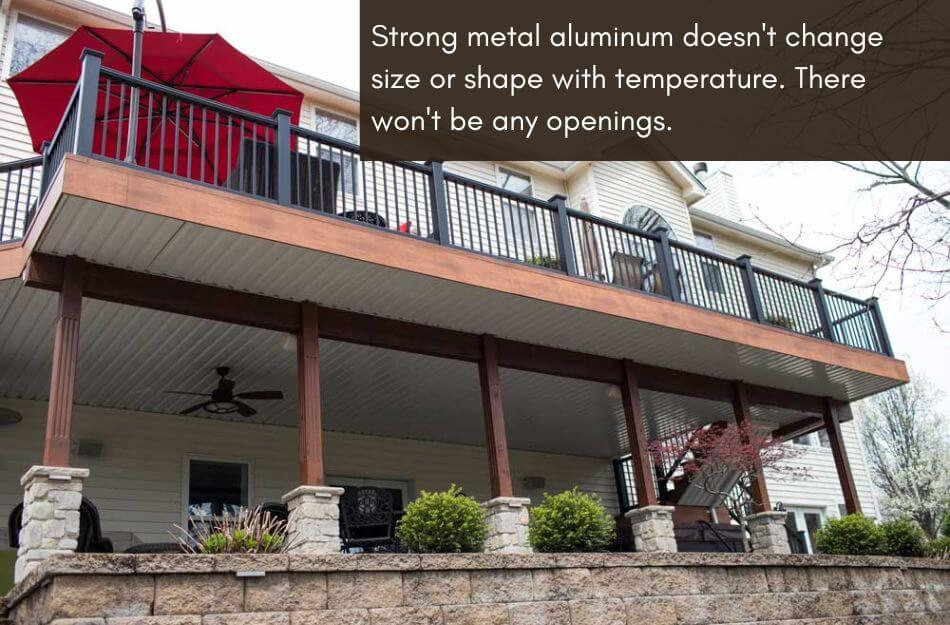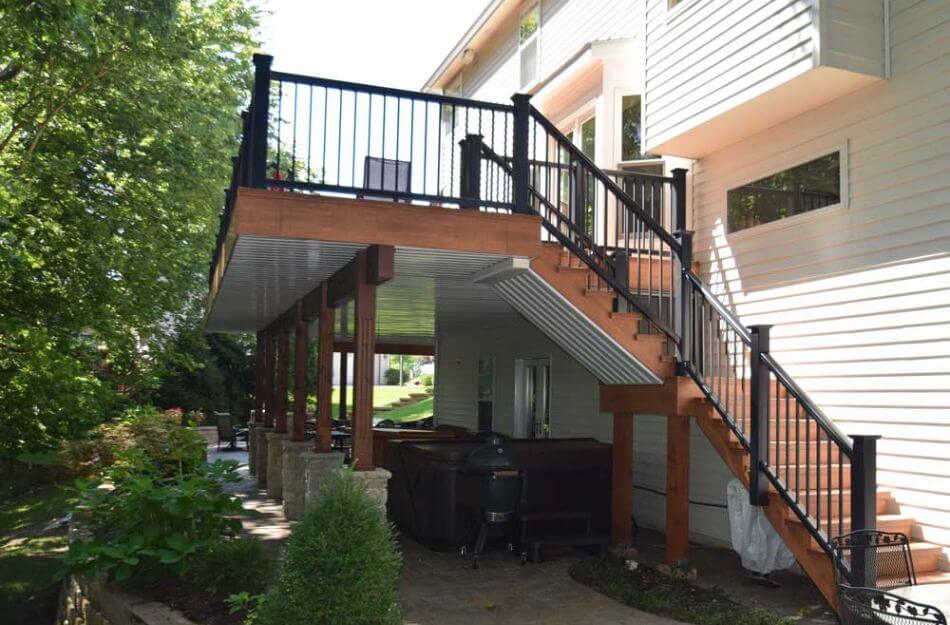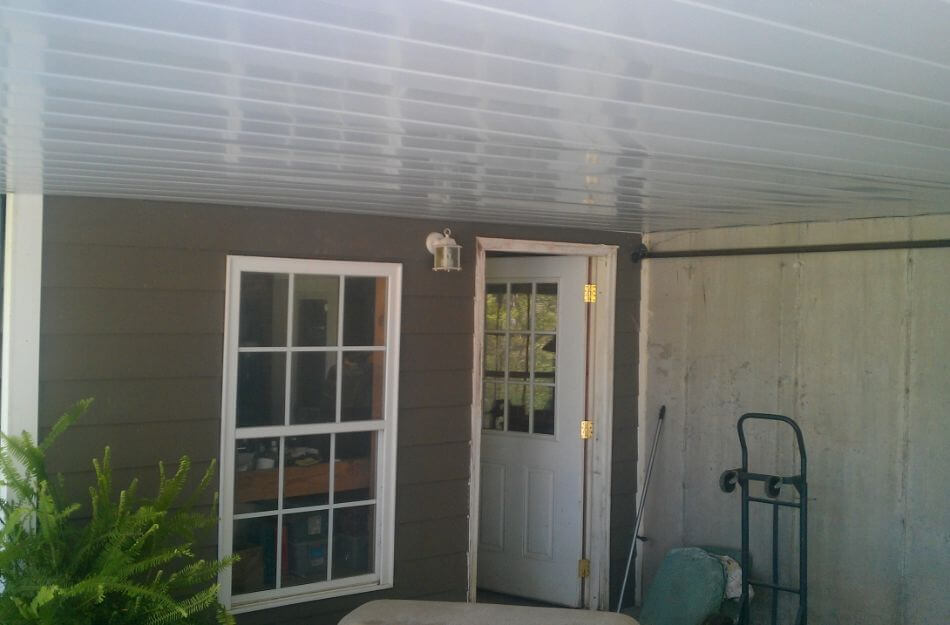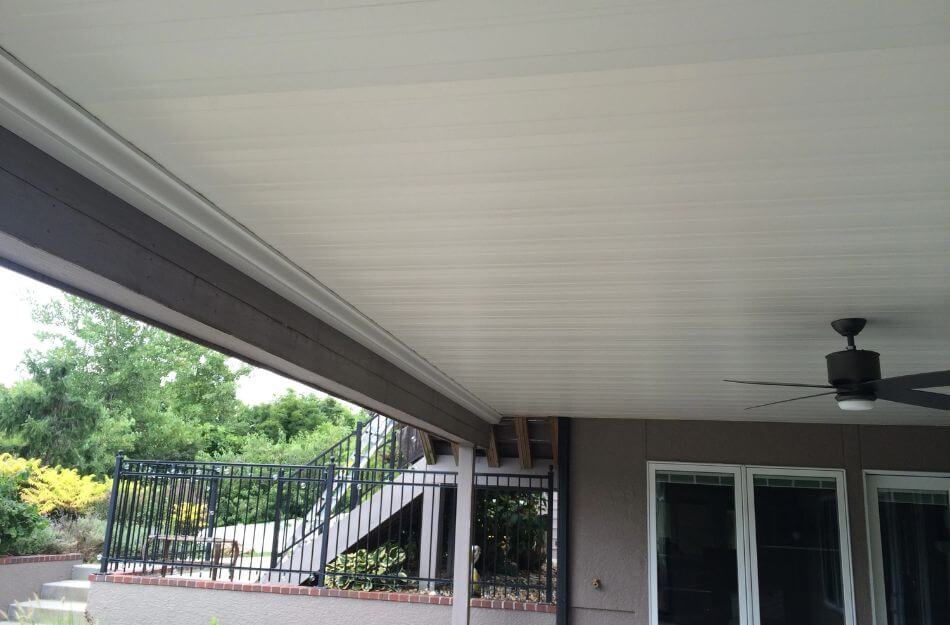Constructing a water drainage system and a perfect under-deck ceiling is necessary. Suppose your floating deck has a functional area below it.
aluminum meets all the requirements for an under-deck ceiling material: resilient, long-lasting, and impenetrable. aluminum is an expensive purchase, though.
Consider the benefits of selecting aluminum instead of steel if you are still trying to decide.
Strong metal aluminum doesn’t change size or shape with temperature. There won’t be any openings. As a result, It prevent problems with water seepage over things under your deck.
The aluminum under-deck ceiling is lightweight, unbreakable, waterproof, and robust. Additionally, it can hold electrical fittings.

The advantages and disadvantages of putting aluminum panels as your under-deck ceiling will be covered in this piece. We’ll also discuss why aluminum is a better material than the options.
By the conclusion of this article, you’ll understand all the advantages of aluminum under the deck ceiling, making it the ideal option for your upcoming deck renovation.
Table of Contents
What Advantages Do Aluminum Under Deck Ceiling Installations Offer?
The most popular under-deck ceiling substance is aluminum with the advantages of durability, strength, and resistance against weather and water.
The second-best choice is vinyl; most people must determine which is better. However, installing the deck ceiling system with metal rather than vinyl would be beneficial. Why is this:
Durability Of Aluminum Panels:
Aluminum’s biggest strength is its durability, which is also one of its advantages. It won’t fracture, flake, rust, or bend. Vinyl systems deteriorate and sag over time.
The vinyl and additional panels can bend and degrade in wetness, ice, snow, and weather conditions, but they are impervious to these elements.
aluminum has superior tensile strength and a much higher ventilation effectiveness than any other material. It can endure extreme heat and snow accumulation without suffering any damage.
Also Read: Waterproofing Under The Deck: The Most Effective Solutions
Brittle yet Hard To Cut
Because aluminum is more durable and hard-wearing than vinyl, cutting it is more challenging. But this is fine since there are thinner metal columns on the market. Using a tin sniper, anyone can simply cut these panels.
Aesthetic And Easy Upkeep
Internal and external living spaces must be aesthetically pleasing and simple to maintain. aluminum is the best esthetic substance to use over under deck ceilings. It doesn’t require other paintings and requires only basic care.

Metal is accessible in various colors that do not deteriorate over time, unlike vinyl. Most metal roofs for under decks made of aluminum are custom-made to fit your deck and meet all your outdoor living needs.
Bird and Water Resistance
The aluminum under deck ceiling sections needs more room for birds to build nests. Birds can’t get in at all.
Additionally, because aluminum panels are sufficiently sturdy to support water drainage and do not leak, they eliminate the chance of water leakage.
Electric Fixtures
The ability to install lighting fixtures and power settings is metal under the deck ceiling’s greatest benefit. The vinyl ceiling cannot support fans and lamps while moisture is kept at bay.
On the other hand, aluminum can support electrical fittings and water drainage independently without creating any issues.
What Is The Cost of Aluminum Under Deck Ceiling?
aluminum flooring costs between $12 and $15 per square inch, while the national average is closer to $13.
The work cost can vary significantly depending on several variables, including the geographic location, site specifics, and even the installer’s degree of expertise.
A typical upfront assumption is that materials account for about one-third of the project’s overall expense.
Different Types of Aluminum Decking
There are fewer choices available for aluminum decking than for other materials.
You do have various aluminum decking material choices, many of which can be modified to fit a variety of designs and purposes. The following are a few of the most crucial categories:
Waterproof Aluminum Decking
aluminum is a water-resistant material by nature, but deck makers have also developed designs that offer a watertight area under the deck.

A waterproof aluminum decking platform can create new areas for storing or social events by using interconnected structures, which leave no openings and channels to guide the water.
Because of this, watertight aluminum decking may be a desirable choice for regions that regularly experience heavy rainfall, though these designs do raise the cost of installing a deck.
Aluminum Decking Boards
There are many various sizes available for standard aluminum decking boards.
A conventional selection of aluminum decking boards with the typical gap between each one, allowing rainwater to pass, is also available, in contrast to aluminum decking intended to create a dry area underneath.
It can lower the total cost of your project and give you the flexibility to add a waterproof drainage system.
Related: Under Decking Ceiling Panels: Things You NEED To Know
Aluminum Decking Finishes
An aluminum decking material’s most popular finish is a powdery coat, which offers a limited palette of color choices and some texture that can help prevent slips and falls. The most popular substitute is metal with a mill finish. It looks sterile and functional, making it ideal for tasks where aesthetics are less important.
Popular marine applications for this style of finish include docks. Some companies coat their decking in Polyurea, a unique type of epoxy-like substance, in addition to standard finishes.
color retention is a crucial performance characteristic to pay careful attention to with coated aluminum.
The most popular standard used by makers of metal coatings is AAMA 2604. AAMA 2604 is a standard that specifies a declining level of 5 Delta E over 5 years (measured in Delta E).
Most composite material producers provide 25-year fade warranties that guarantee the same 5 Delta E degree of color fading over that time. It means that composites exposed to UV for an extended time are frequently more color fast.
Aluminum Deck Frame
There are benefits and drawbacks when employing an aluminum joist system to hold your deck, just like aluminum decking boards.
aluminum is about threefold stronger than wood, absent a defective product. It enables longer separations between deck supports.
aluminum deck frames are much more stable than wooden ones because they are less likely to warp or fracture. However, aluminum substructures are very expensive and hard to find.
Steel Vs. Aluminum Under Deck Ceiling
aluminum and steel are the two metallic under-deck ceiling components that many homes must choose between.
However, the two elements are completely dissimilar from one another. Each has benefits and drawbacks. As opposed to a steel system, an aluminum system is more advantageous for the reasons listed below:
The Strength-to-Weight Ratio
Superior “durability to weight” is a property of aluminum. In other words, even though it is not as strong as steel, its weight is twice as little as steel makes up for its lower strength.
For this reason, the bulk of airplanes is constructed of aluminum. aluminum panels are preferable to steel because they will be sturdy and light simultaneously, regardless of your width.
You May Also Like: How To Put Gravel Under the Deck?
Rust resistant
Steel is more susceptible to rust and rusting than aluminum. aluminum is strongly resistant to heat and moisture in the air, so it doesn’t rust or corrode.

Versatility
Because aluminum is more adaptable than steel, it is the ideal material to use in your house. Steel is harder to cut, saw, bend, drill, and process than aluminum.
Resilience And Aim
Homeowners’ steel systems, which are usually made of corrugated steel roofing sheets, are common. Because it is not designed to be an under-deck ceiling panel, this steel sheeting frequently only lasts a year or two before collapsing.
Steel sheet joints are readily permeable. However, aluminum panels can readily last ten years with little upkeep. Even better, power cleanses them with mild soap.
How Should Aluminum Under Deck Ceiling Be Maintained?
An aluminum under deck ceiling can be maintained through regular cleaning. An underdeck system is an excellent choice if you want to create an open area underneath your deck.
The advantage of having an aluminum underdeck roof is its easy maintenance. You must take specific steps to maintain it.
A Quick Sweep
Cleaning the ceiling over your deck is relatively easy. A quick sweep with a scrubber or long mop is usually needed to remove accumulated grime, filth, and spider webs.
Clean Panels
For cleaning the ceiling panels, use a household detergent or spot remover. Water and dish detergent together is a great alternative. Use a wet sponge or handkerchief to prevent panel scratches.
Power washes With Caution
Although you must keep your power washer’s settings at their lowest, power washing the region of the upper deck or the aluminum sheets below won’t harm them.
Remember to remove any valuables and electrical fixtures before you begin washing. You don’t want to get wet.
Final Thoughts
While plastic and steel are among the many materials used for under-deck ceilings, aluminum is the sturdiest. It requires the least care and endures for a decade without cracking, chipping, scratching, or rusting.

Aluminum under deck ceiling panels is stronger and more resilient than steel, which is more costly. As a result, you ought to place aluminum under the deck ceiling.
Just be sure to cleanse the aluminum deck using the methods described above.
Recent Posts
Although deck sealing may not be at the top of your summer to-do list, you shouldn’t put off a task.One such deck that channels the opposite of the lively and enjoyable vibe you want from an...
Any home would benefit from having a deck because it adds more area for socializing, relaxing, and outside activities.Garden decking that has been properly polished can be elegant and lovely. It...
